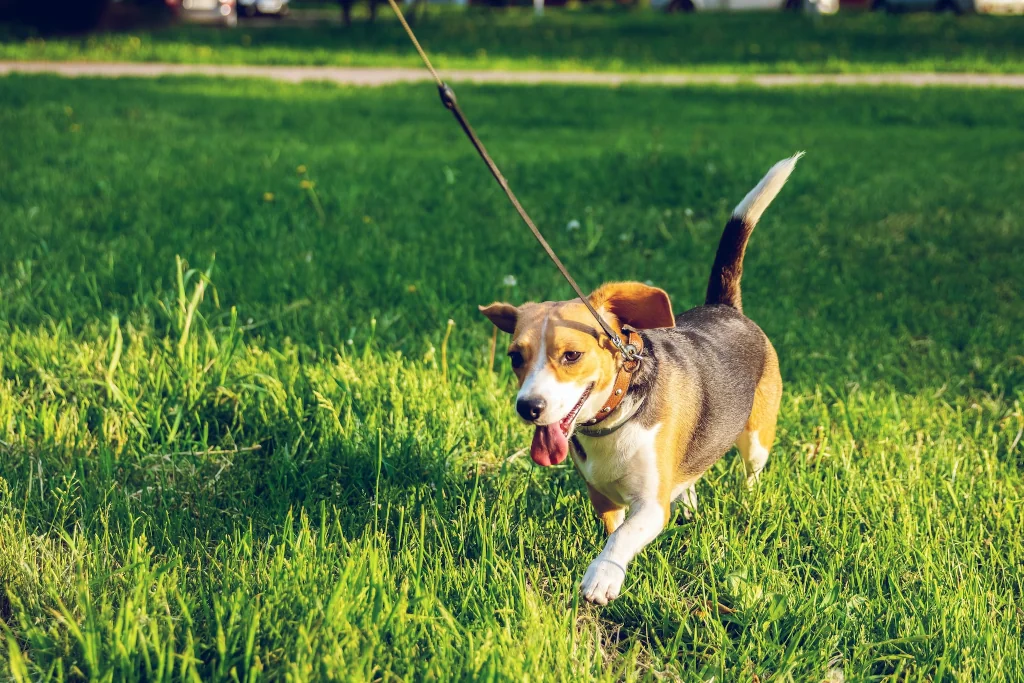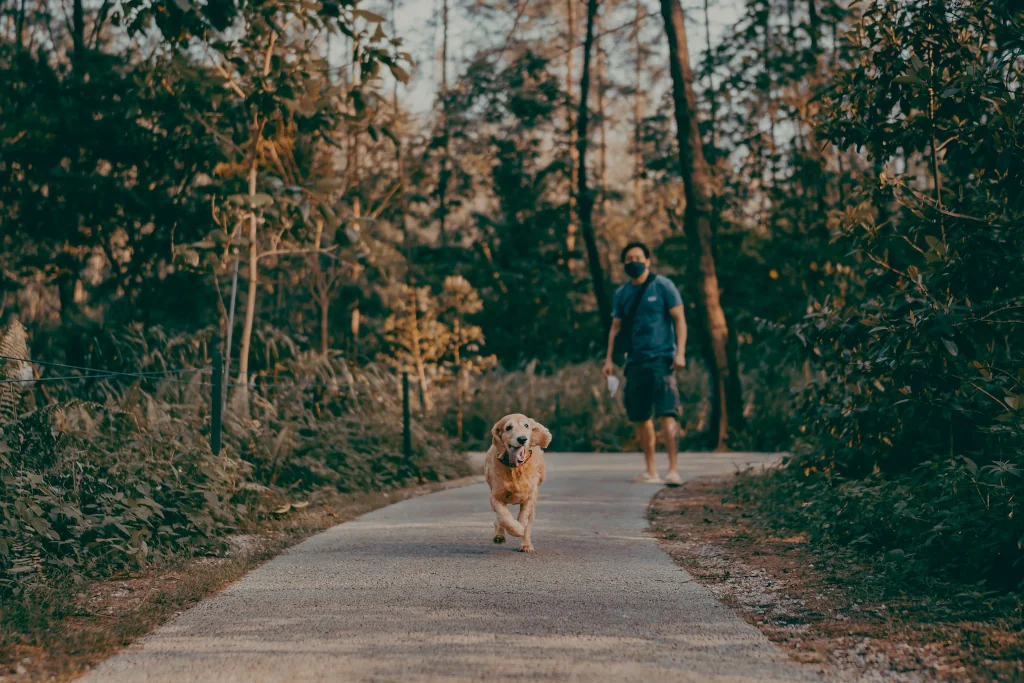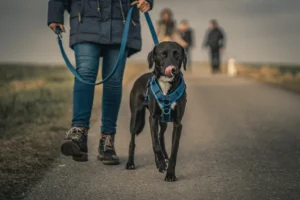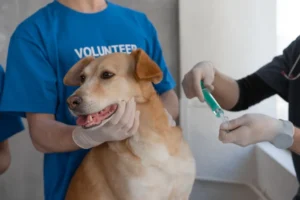Just as humans do, our canine companions thrive on a healthy dose of exercise.
However, not all exercises are created equal – especially when it comes to dogs. Breed, size, and age, all major factors, add layers to what we call ‘the right kind of exercise’.
Simply throwing a ball in the park might be thrilling for your energetic Lab, but what about your aging Bichon Frise or your laid-back Bulldog? As much as we adore our dogs, balancing their exercise needs can sometimes feel like a guessing game.
But here’s a secret: it doesn’t have to be. Welcome to the art of tailoring exercises to your dog’s unique needs. It’s simpler than it sounds.

Why Does Exercise Need to Fit Your Dog?
Ever wondered why your neighbor’s Great Dane seems to be content with a leisurely stroll while your Jack Russell Terrier runs tirelessly?
Or why your Greyhound sprints like a racehorse, yet tires quickly? It’s because each breed of dog comes with its own set of physical characteristics and inherent behaviors.
These traits influence the type, intensity, and duration of exercise they need.
For instance, herding breeds like Border Collies have high energy levels and are built for endurance. On the other hand, a Shih Tzu, a toy breed, is likely to prefer shorter periods of activity.
Knowing this helps us ensure our furry friends get exercise that’s not just adequate, but also appropriate. And trust us, when your dog gets what it needs, you’ll notice the difference – a happier, healthier, and more content companion. Now that’s something to bark about!
What Influence Does Breed Have on Exercise?
Dog size plays a vital role in determining the type and amount of exercise they need. Here’s how:
Large Breeds – Dogs like Mastiffs or Newfoundlands have slower metabolisms and are prone to health issues like joint dysplasia. While they need regular exercise, intense activity isn’t necessary. Gentle walks, swimming, or a game of fetch work well.
Small Breeds – Small dogs like Jack Russell Terriers or Beagles have boundless energy. They need a significant amount of exercise to maintain health and behavior. Activities such as agility training, hide and seek, or a game of chase can be ideal.
Medium-sized Breeds – This diverse group includes breeds like Border Collies, Bulldogs, Cocker Spaniels, and Dalmatians, each with their unique exercise needs.
For instance, Border Collies thrive on mental and physical challenges and require at least an hour of exercise each day, including training and socialization activities. Bulldogs, on the other hand, can struggle with excessive physical exertion due to their brachycephalic nature, so short 15-minute walks twice a day would suffice.
Cocker Spaniels are active and enjoy longer walks of up to an hour, alongside activities that work their brain like fetch or obedience training.
Dalmatians, originally bred to run alongside carriages, have high endurance and benefit from longer-duration exercises like jogging or playing fetch for an hour or two.
Toy Breeds – Even though these tiny dogs can fit in a bag, they still need daily exercise for overall health. A short walk or some indoor playtime can suffice.
Here’s a quick summary of recommended exercises based on breed:
| Dog Size | Examples | Recommended Exercises | Duration |
| Large | Mastiffs, Newfoundlands | Gentle walks, swimming, fetch | 30 minutes – 1 hour |
| Small | Jack Russell Terriers, Beagles | Agility training, hide and seek, chase | 1-2 hours |
| Medium | Border Collies | Mental/physical challenges | 2 hours |
| Bulldogs | Avoid excessive exertion | 30 mminutes | |
| Toy | Chihuahuas, Pomeranians | Short walks, indoor playtime | 15-30 minutes |
The goal is to understand your dog’s unique needs based on their size and tailor their exercise regimen accordingly. Always remember, a balanced exercise routine is crucial for your dog’s happiness and health.

Size and Exercise: What’s the Connection?
Each breed of dog has distinct exercise requirements based on their unique physical attributes and temperaments. Here are some examples:
- High-Energy Breeds. Breeds such as Border Collies, Australian Shepherds, and Labrador Retrievers are highly active and require intensive exercise. Labrador Retrievers, for example, can benefit from 1 to 2 hours of exercise a day, including activities like jogging, swimming, and agility training.
- Hunting and Sporting Breeds. Breeds like Beagles, Pointers, and Retrievers were bred for work and have abundant energy. Beagles love to follow their nose, so exercises like fetching, tracking, and swimming for up to an hour daily would suit them well.
- Herding Breeds. Breeds such as German Shepherds and Belgian Malinois are natural workers. German Shepherds, being an active breed, require about 2 hours of exercise a day that includes both physical and mental stimulation like training exercises or agility courses.
- Brachycephalic Breeds. Short-nosed breeds like Bulldogs and Pugs have breathing difficulties. Bulldogs, due to their unique physical attributes, need less strenuous and more controlled exercise like short walks of about 15 minutes or gentle play.
- Toy and Small Breeds. Despite their size, small breeds like Chihuahuas and Pomeranians need regular exercise. Chihuahuas are lively dogs and benefit from 30-minute walks and indoor games to keep them active.
And here’s a table summarizing this:
| Category | Examples | Recommended Exercises | Duration |
| High-Energy Breeds | Labrador Retrievers | Jogging, swimming, agility training | 1-2 hours |
| Hunting and Sporting Breeds | Beagles | Fetching, tracking, swimming | Up to 1 hour |
| Herding Breeds | German Shepherds | Training exercises, agility courses | About 2 hours |
| Brachycephalic Breeds | Bulldogs | Short walks, gentle play | 15 minutes |
| Toy and Small Breeds | Chihuahuas | Short walks, indoor games | 30 minutes |
Exercise needs can vary widely even within the same breed, so always consider your individual dog’s health, age, and preference. A tailored exercise plan will help your furry friend stay happy and healthy.
Is Age Just a Number When Exercising Your Dog?
While your dog’s spirit might be ever-youthful, age does play a pivotal role in determining the right exercise regimen. Let’s break it down by life stage:
Puppies – Handle with Care. Despite their boundless energy, puppies’ bodies are still developing, making them more susceptible to injuries. Keep exercise sessions short and frequent, ideally five minutes per month of age, up to twice a day. Instead of high-impact activities like running on hard surfaces or jumping, opt for controlled games or puppy training classes.
Prime Time for Adult Dogs. This is when most dogs can handle more robust activities. Depending on the breed and individual health, adult dogs can enjoy longer walks, hikes, or dog sports like agility or flyball. For instance, an adult Border Collie could thrive on a solid hour of exercise each day, including mental stimulation like puzzle toys or advanced obedience training.
Senior Dogs – Age Gracefully. As dogs age, their energy levels decline, and they may experience joint problems. It’s essential to adapt their exercise routine to a gentler pace. Shorter, more frequent walks and low-impact exercises like swimming are ideal. A senior Labrador, for example, might benefit from two 20-minute walks a day, along with light swimming sessions.
Here’s a summary table for quick reference:
| Life Stage | Exercise Type | Example Duration | Notes |
| Puppies | Short, frequent play sessions | 5 minutes per month of age, twice a day | Avoid high-impact activities |
| Adult Dogs | Longer walks, hikes, dog sports | Varies by breed; e.g., 1 hour for Border Collies | Include mental stimulation |
| Senior Dogs | Short walks, low-impact exercise | Varies by breed; e.g., two 20-minute walks for Labradors | Adjust for declining energy and joint health |
Unique Tip:
Age certainly isn’t just a number when it comes to exercising your dog. Paying attention to your pup’s physical and emotional development will help you provide the best care throughout their life stages.
Creating the Perfect Exercise Routine: How?
Crafting the ideal exercise routine for your dog isn’t as complex as it sounds. It’s about finding balance, keeping it varied, and tuning into your dog’s needs. Here’s a practical guide:
- Regularity is Key. Aim for daily exercise. Regularity helps keep your dog physically fit, mentally stimulated, and minimizes behavioral issues.
- Mix it Up. Vary the types of exercise. Mix in walks, fetch, swimming, or training games to keep it interesting. Different activities stimulate different muscles and keep your dog engaged.
- Start Slow, Build Up. Especially with puppies or older dogs, start with smaller amounts of exercise and gradually increase the duration and intensity as they become more fit.
- Monitor Their Response. Keep a close eye on your dog during and after exercise. If they seem overly tired, are panting heavily, or show any signs of discomfort, it’s time to slow down.
- Adapt and Modify. Dogs’ needs change with age and health conditions. Be prepared to adapt their exercise routine accordingly. For instance, swap high-impact runs for gentler walks as they grow older.
Quick Tip:
Now, let’s move on to some common queries we often get.
FAQs
Can I over-exercise my dog?
Over-exercising your dog is possible and can lead to exhaustion or injuries. Monitor for signs such as extreme fatigue, reluctance to move, limping, or panting.
What are some signs my dog isn’t getting enough exercise?
A dog that needs more exercise might show signs like restlessness, excessive barking, chewing, or other destructive behaviors.
Are there dog breeds that require minimal exercise?
Breeds such as the Basset Hound, Shih Tzu, and Bulldog typically require less physical activity compared to other breeds.
Is it safe to exercise my dog in hot weather?
Take precautions when exercising your dog in hot weather. Stick to early morning or late evening when it’s cooler, keep hydration handy, and watch for signs of heat exhaustion.
Alex, a passionate animal lover, has experience in training and understanding animal behavior. As a proud pet parent to two dogs and three cats, he founded AnimalReport.net to share insights from animal experts and expand his knowledge of the animal kingdom.









